Kitchen Project #31: Basque cheesecake
How to adapt your baking time and tin size for that sooooft centre!
Hello,
Welcome to another edition of Kitchen Projects. It’s so wonderful to have you here.
Today I’m sharing one of my prized recipes - the basque cheesecake. This dessert is such a crowd pleasing classic. For KP, I’ve adapted my OG recipe for a few different sizes and looked deeper into the the baking temps and times and share those discoveries with you below.
Over on KP+, I’m sharing my guide to adapting the basque cheesecake. From infusions to details on how to balance your own recipes, I’m sharing everything I know about this dessert so you can have the power to make your own versions. PLUS, you’ll get the lowdown on this chocolate basque:
Subscribing is easy and only costs £5 per month. So, if you’d like to support the writing, get access to extra content + community chat threads, click below:
Alright, let’s do this!
Love
Nicola x
Long term relationship goals
My relationship with the basque cheesecake - like most of us - begins with La Vina. For months in the run up to our trip to San Sebastian I had been desperate to try THE burnt cheesecake. I’d meticulously planned our eating schedule to include several stops at La Vina. The ‘meticulous planning’ however, did not include er… checking if it was open?
As much as visiting San Sebastian in February is dreamy for the shorter queues and less hectic streets (still good vibes tho), it did mean missing out on the cheesecake I’d been dreaming of. Don’t worry, I commiserated myself with plenty of tkaxoli and torrijas instead.
So, it wasn’t til a year later that I got my first taste of a basque style cheesecake, which ended up being at La Tarta de la Madre de Cris, a beautiful little shop on the corner of a plaza near Granada. After a 3-mile hike accidentally turned into an 8 mile hike thanks to a few wrong turns, we drove straight to the plaza knowing cheesecake would be there waiting for us. We ate two slices in succession and it was glorious - moussey, creamy, dense with a spotted, caramelised crust. I was hooked.
Since then I’ve made it a LOT at home. At the puff pop-ups last year we had an issue with a dessert we’d called ‘puff party cake’ and decided not to serve it at 11pm the night before opening. Not wanting to be empty handed when it came to something as festive as ‘party cake’, I whipped up a couple of panic-basque cheesecakes at 4AM, just hours before we were due to open, and the puff party cake became the puff party cheesecake. Problem solved.
Ever since then I’ve aways seen the basque as an emergency cheesecake - you can whip it up in about 10 minutes, give or take, and it is a guaranteed crowd pleaser. Although I know a few anti-basquers, the texture is so enticing that even a naysayer would probably go for a slice - even if it was only a little one.
Whilst the La Vina OG slice is still very much on my must eat list, I guess we’re pretty lucky these days - basque is prolific - and anyway, I’m going to share my recipe here with all the details on how to get it *just how you like it* so you can make all your cheesecake creams come true.
A disclaimer
A disclaimer? This early on?! I know. This week, I did a lot of tests to try and make this recipe as foolproof as possible. It’s not that the recipe itself is hard, it’s that the cooking can be a bit unpredictable due to variation in ovens. Anyway, I’m not too worried - I reckon we’ll still smash it, but - but as I’ve found, you have to be prepared to work with the limitations of your oven.
If your cheesecake hasn’t browned to your liking, know that La Vina itself doesn’t always have an evenly browned crust at all, and it’s all part of the unique magic of baking:
The formulation
My basque recipe - like all of them - is pretty simple: Lots of cream cheese, eggs, sugar, sour cream and double cream. I think the sour cream adds essential tang, building on the base of the cream cheese. I spent months balancing it to get it quite right only to suddenly overcook it and realise that now it was perfect, I needed to spend MORE time staring at my oven.
Basque is all about the texture. Although the ingredients are important, it’s the baking tin and baking time that makes the most impact at home. One of the biggest challenges I’ve also found with basque is achieving good results in a smaller tin so this week I set out to devise the perfect recipe for a 6inch tin. Yes an 8inch - or even 10 inch - can feed a crowd and is glorious, there’s something lovely about a smaller one. Much more transportable and a bit less intimidating.
All about your oven
Getting to know your oven is an essential step. If you don’t have an oven thermometer at the moment I’m going to have to ask you to resolve that if you want to get consistent results with your basque.
Of course you can make your recipe without one, but reducing as many variables as possible is advisable. All ovens have their quirks, which makes them more loveable of course, so knowing what yours are is going to be really helpful.
I’ve spoken to a few bakers who tell me they bake their basque on ‘max’…. but what is that? The ‘max’ temp oven to oven varies hugely - as basque needs a HOT oven, knowing what your max capacity is very useful. My current oven has a max of 300c+(!!!). Of course, I couldn’t resist trying it at that extreme level. You’ll see the results below…
That dark crust and gooey middle
One of the biggest issues that people have with their basque cheesecake is getting the right proportion between caramelised crust and gooey interior which is essentially achieved by ‘overcooking’ the outside and ‘undercooking’ the middle - a bit like a chocolate fondant. That means we need to bake it HOT and FAST if you really want it to be like a mousse inside after it has chilled.
Much like the pasteis de nata, when you’re browning your cheesecake, there’s two things going on. Firstly, you’ve got the milk solids that are browning. These compounds are undergoing the maillard reaction. To give you a recap on that, this is the reaction between amino acids (proteins) and sugar. In order for it to take place, it needs heat, resulting in delicious toasty and browned flavour compounds are created.
Secondly, the sugars (lactose and sucrose) are also caramelising. That being said, the significant browning is mainly from the milk solids, though the sugar does contribute to the flavour profile.
How gooey is gooey?
If you want your basque cheesecake to have that very wet, almost liquid centre then it’s advisable not to refrigerate it. But this is a bit dangerous! If you do try this, make sure you leave it to come to room temp (at least several hours) before cutting.
At La Vina, the cheesecakes are baked on the day that they’ll be served, accounting for the sometimes molten centre. That’s the charm of La Vina (according to Insta tagged photos), the goo is not always guaranteed and varies from bake to bake.
Ed Smith put it perfectly recently on Insta. He said “it seems the trend here now is to see how burnt yet gooey you can get it. A little bit 'how big's your d*ck' on a part of the kitchens. But not with terrible results for we consumers.” So, if your goal is burnt but gooey - GET YOUR OVEN TURNED UP TO MAX and I mean max, and prepare for a very short bake - sub 20 minutes.
I personally prefer a more densely set cheesecake with a lightness when you eat it rather than a totally liquid experience, so I’ve tried to maximise my recipe for that end effect. A wibbly bit in the middle is perfect for me.
How dark should ya go?
Instagram would have you believe that having a perfectly and evenly burnished crust is the “right” way to have a basque. But I’ve learnt - the hard way - that ovens don’t always want to play ball. You may find that your oven prefers to be a bit more… er, artistic? As a result, you might end up with a cheesecake that is not evenly browned and you know what? THAT’S OKAY! As my friend Milli pointed out, it’s a bit like cooking a big steak and sharing it out depending on who wants the rare bit etc. etc.
With the 8 inch basque, I find the caramelisation is pretty even. But for the 6inch it can be a bit more challenging. Although you need to be careful not to let too much heat out, I do check my basque at the 10 minute mark and turn it around if needs be to get it even, repeating this every 5 minutes until the bake is complete.
Bigger is not always better
When I revisited my original recipe for KP, I wanted to reduce the size slightly to make it a bit more user friendly. As much fun as clearing out the cream cheese shelf in the supermarket is, the 900g cream cheese + 6 egg commitment seemed a bit excessive. However, since the essential texture between burnt top and soft middle is achieved partly by the huge size of the batch - the cheesecake weighed almost 2kg - I knew I’d have to play around with it.
For this batch size, my cooking instructions advised 40-45 mins at 205c fan. This gave me the perfect bake with a soft middle but caramelised exterior. However, to reduce the batch size without impacting the bake, I needed to play around with the temperature and bake. I got to testing, figuring out the perfect depth, size and oven temp:
Here’s some visuals for you:
You know how I kind of love stabbing things with a thermometer? Well, I did for these basques and found that there is considerable carry over cooking and the best basques came out at about 60-65c. Although part of the goo is due to the middle bit of mix literally being undercooked, my preferred moussey texture is achieved by bringing the eggs close to 60c and not going further.
The deal with flour
The flour, which is optional, will depend on your serving plan. I find that a basque baked without flour is quite weepy the following day and having some flour in the mix helps hold the liquid much better. So, if you are planning to make the basque ahead I think it’s sensible to include the flour but if not, you’re free to make it without! I believe any GF flour, including cornflour, would work well if you are making this for coeliacs too. Although it doesn’t impact the final texture (much), it does help keep things solid and hold the liquid in place.
Mini basques and thoughts on 4inch!
One of the things I get asked the most is - can I make mini basques?
The answer, tragically, is not really. I have tried (and failed) many times to achieve a perfect tiny burnt cheesecake and I’ve not been able to figure out how to do it without wildly over baking the middle or forgoing all the colour on top. As much as I’d love to say I’ve found a way to do it, I haven’t!
I don’t own a 4inch tin though I think you *might* be able to achieve that with a super hot oven - if you do have one, my best guess is 300c for 10 mins with a 4.5cm - 5cm deep volume (probably 400g) - check with a thermometer and see if it has reached 62c!
Serving temperature
My preferred serving temperature is room temp, with the chill just taken off slightly. The best way to do this is to take it out of the fridge 45 mins - 1 hour before you want to serve it.
The recipe
To get the texture just so, your oven temp needs to be accurate please. When I say 250c, it needs to be 250c! If your oven is a bit unreliable, I recommend making the original large 8inch size which can be baked at a ‘lower’ temp that may be more achievable.
Method
Pre-heat oven to temperature in the table, dependent on recipe size
Mix cream cheese with paddle until homogenous
Paddle in the sugar until it has dissolved fully - check with your fingers! It should feel totally smooth
Now add the eggs, one by one, scraping down the sides of the bowl to make sure it’s dissolved. Finally, add the sour cream and double cream
Sift the flour and add salt into another bowl
In another bowl, whisk together alternate helpings of cheesecake batter and flour/salt - you’re making a liaison batter here. Ensure it’s smooth before adding it back into the cheesecake
Mix the two batters together, scraping down the sides to make sure its homogenous
Prepare the tin by taking two pieces of baking paper and laying them on top of each other at a perpendicular angle, then press into your baking tin. It should comfortably cover the tin and have a slight collar. You can trim it if its too dramatic
Pour in the cheesecake mixture and tap to level
Bake according to the table above and not a moment longer! If for some reason the batter hasn’t browned too much then don’t worry, just enjoy it. If desired, you can temp your basque! It should be around 60-62c ideally. This temp will raise 5c-10c as it cools thanks to carry over cooking
Leave to cool and then put in the fridge until totally cold
Bring to room temp for 1 hour or so before eating


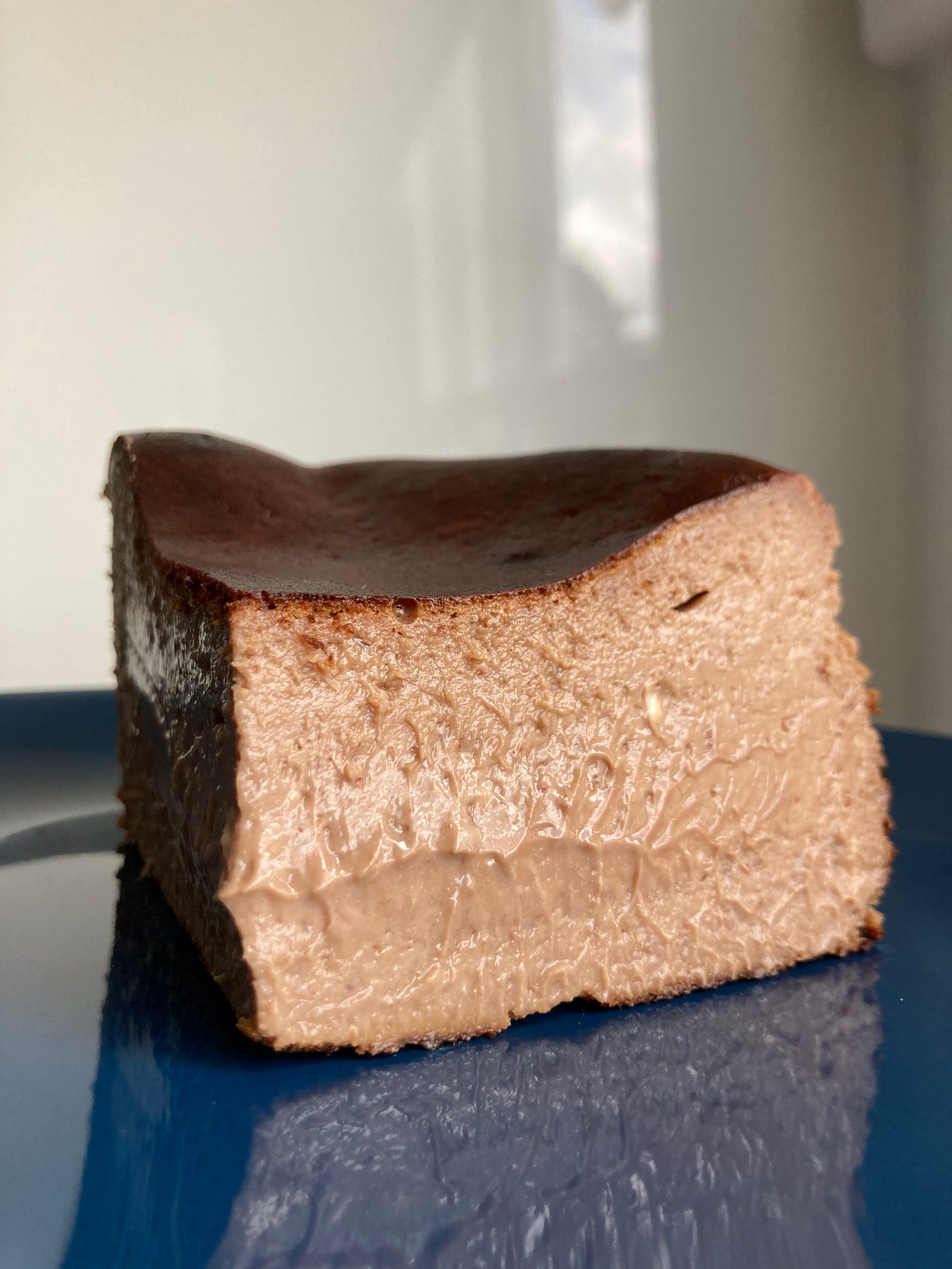
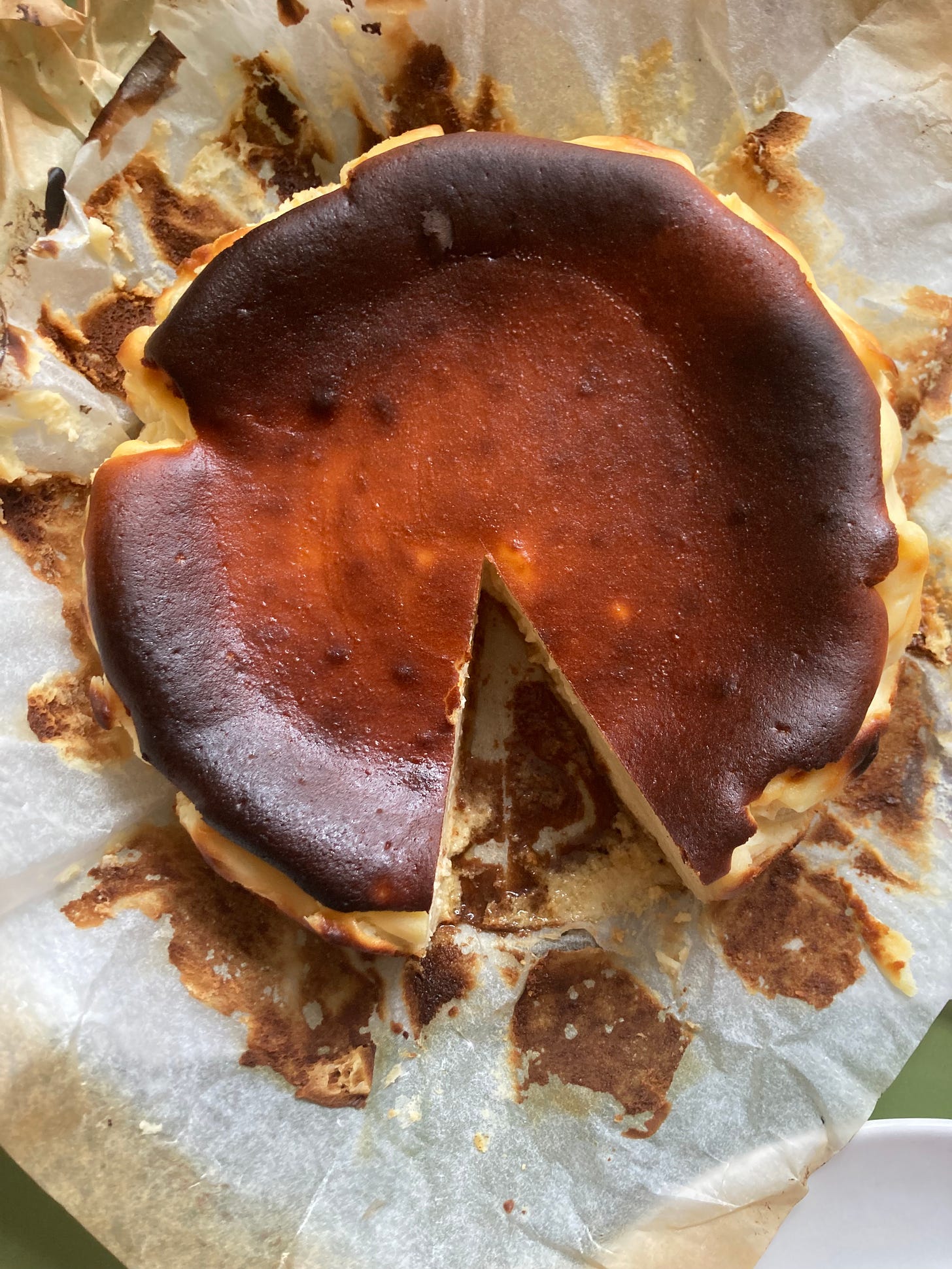
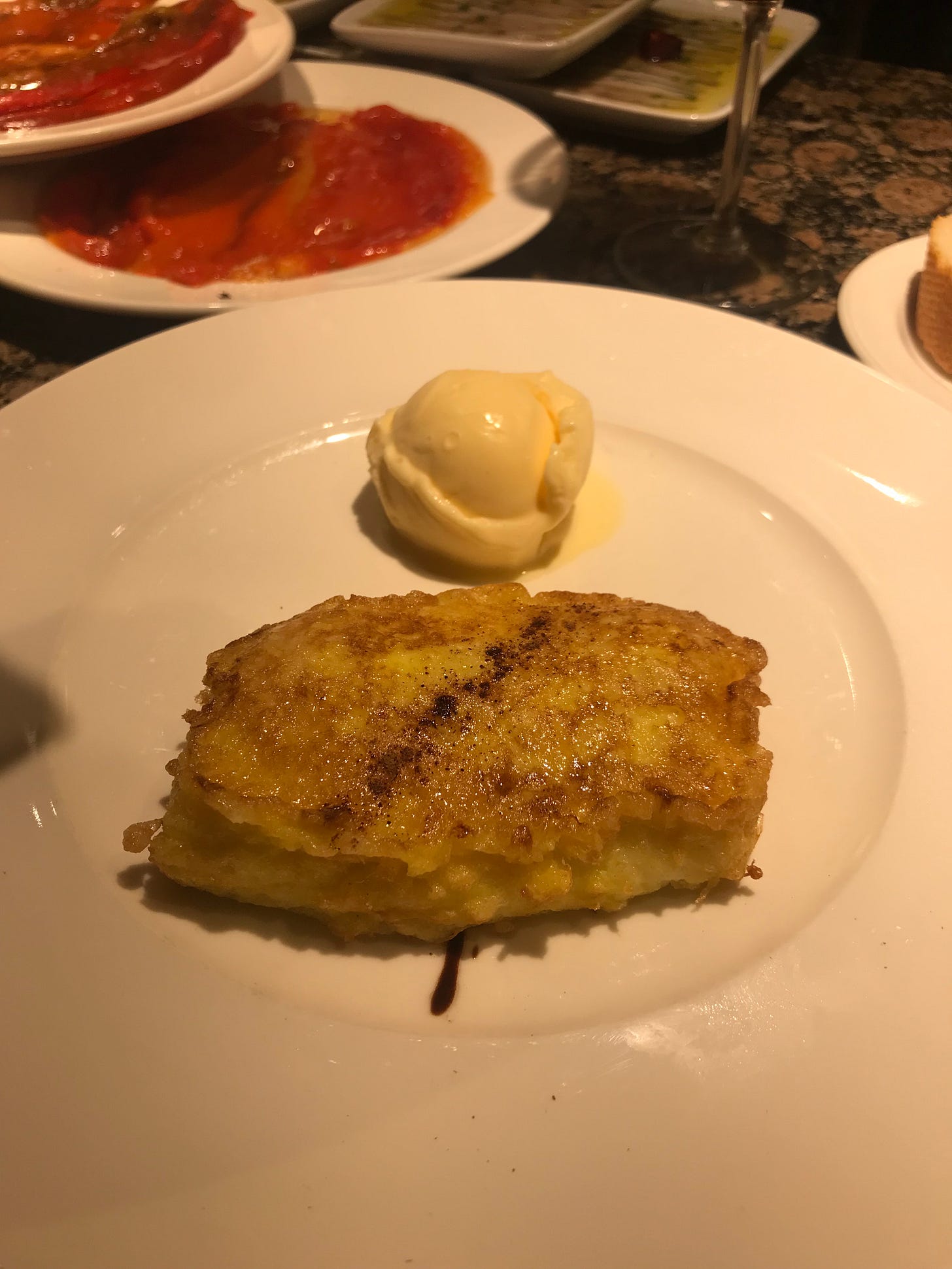
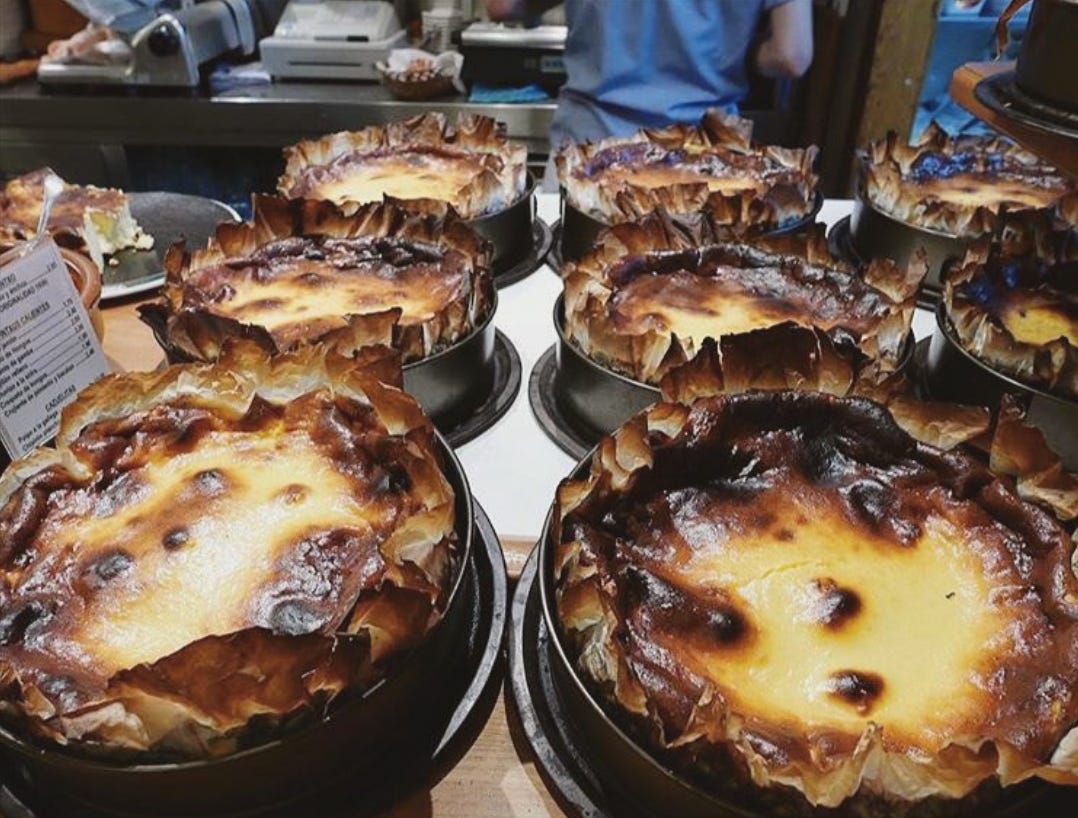
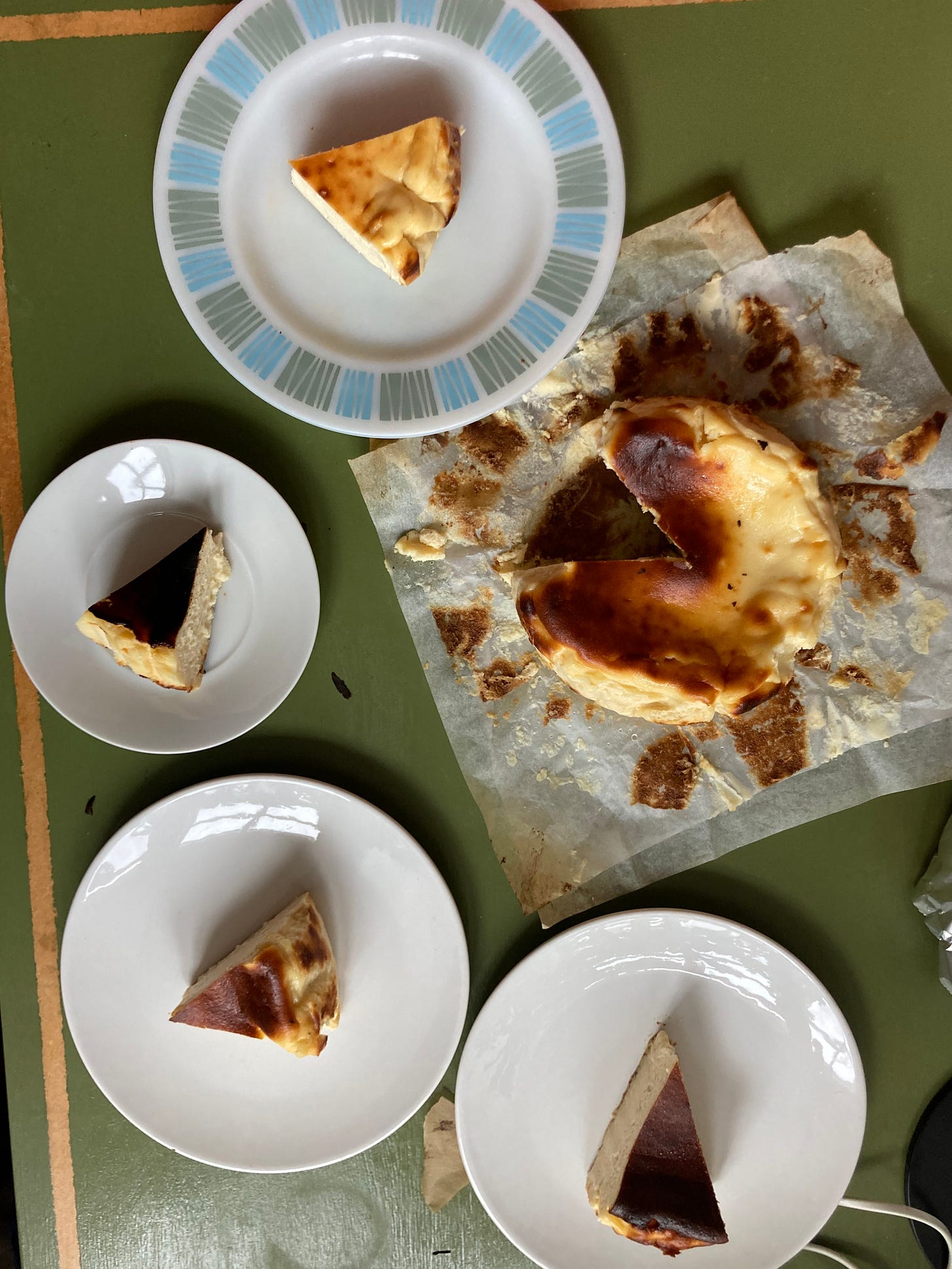
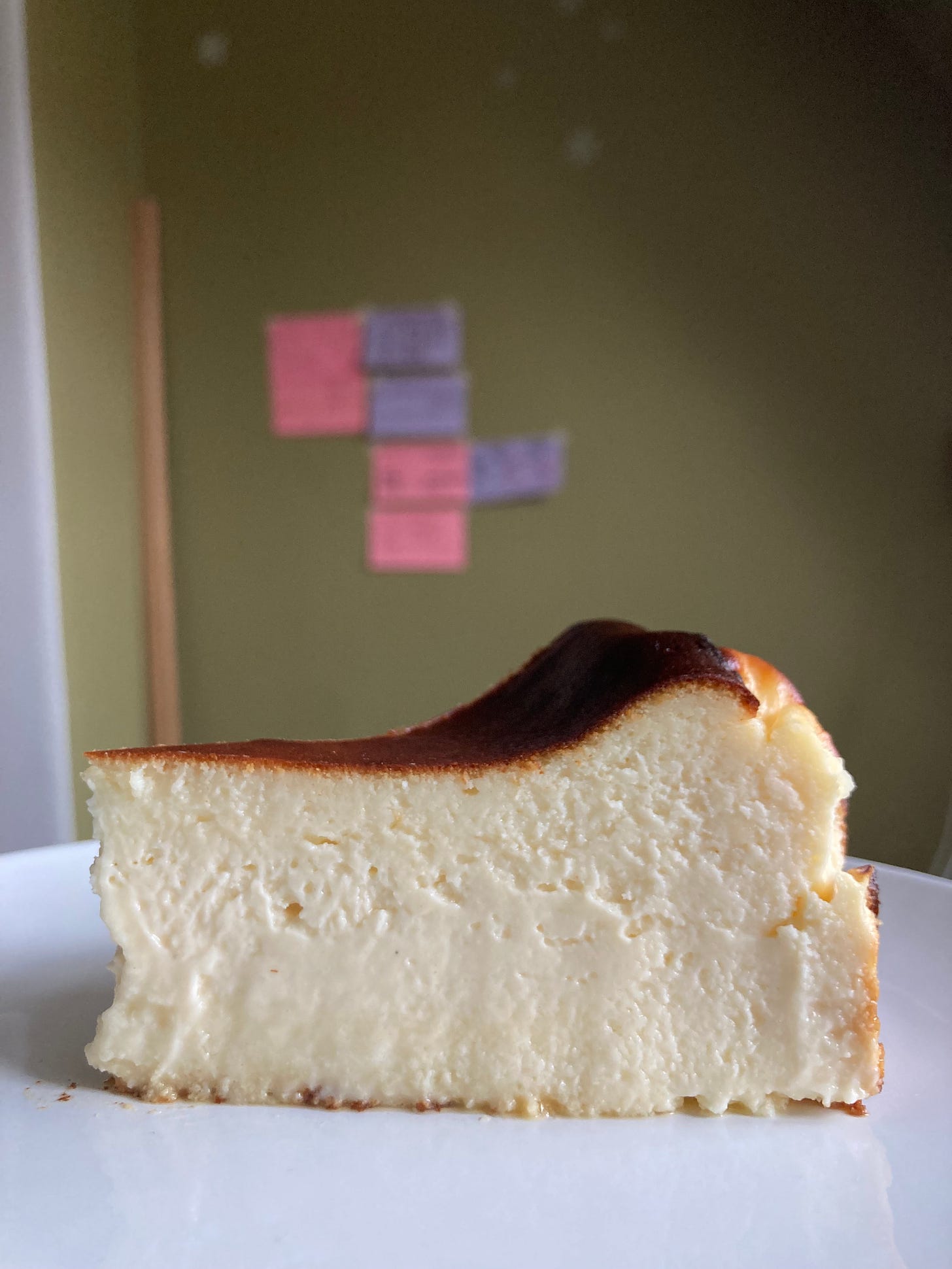
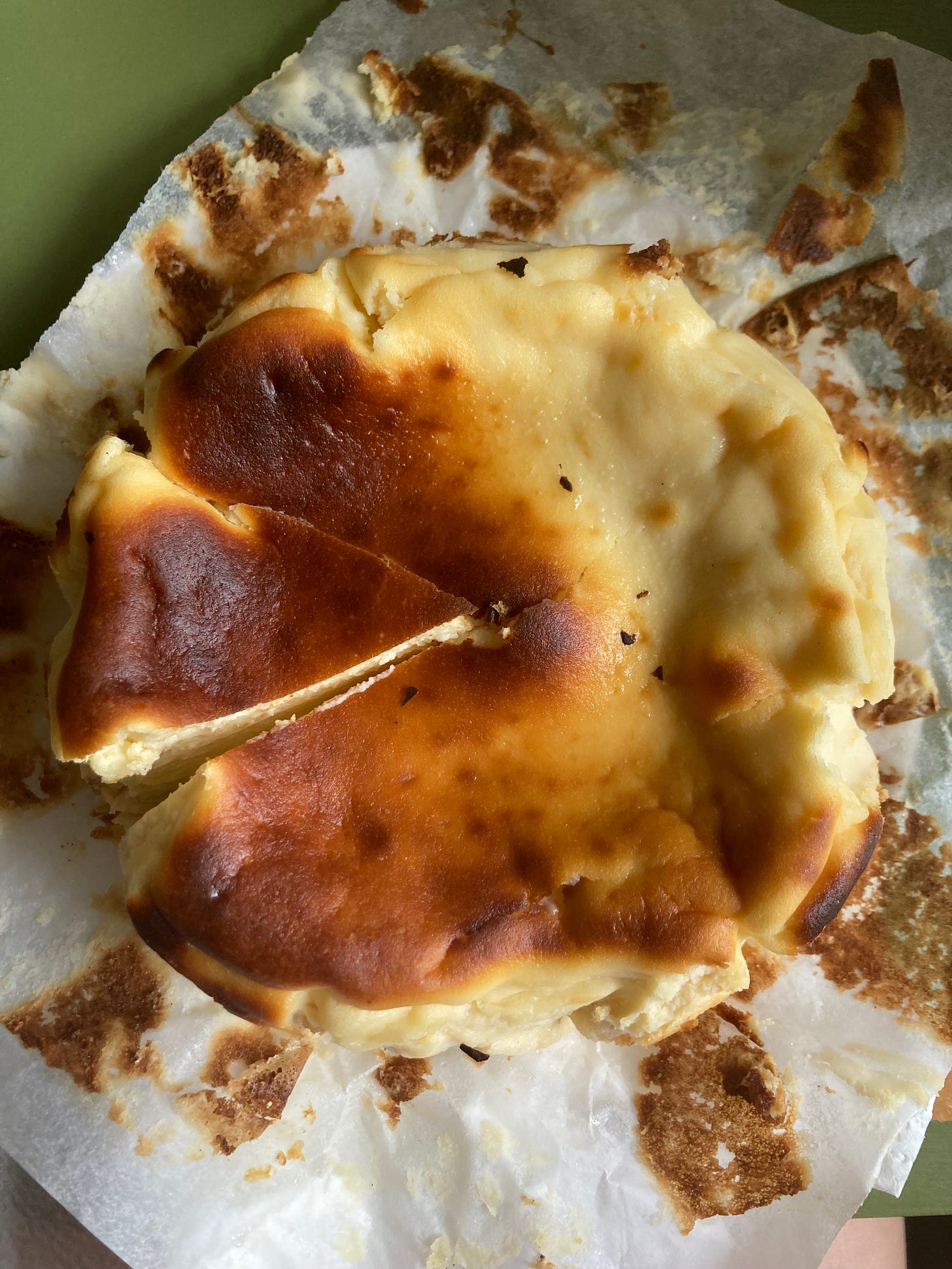
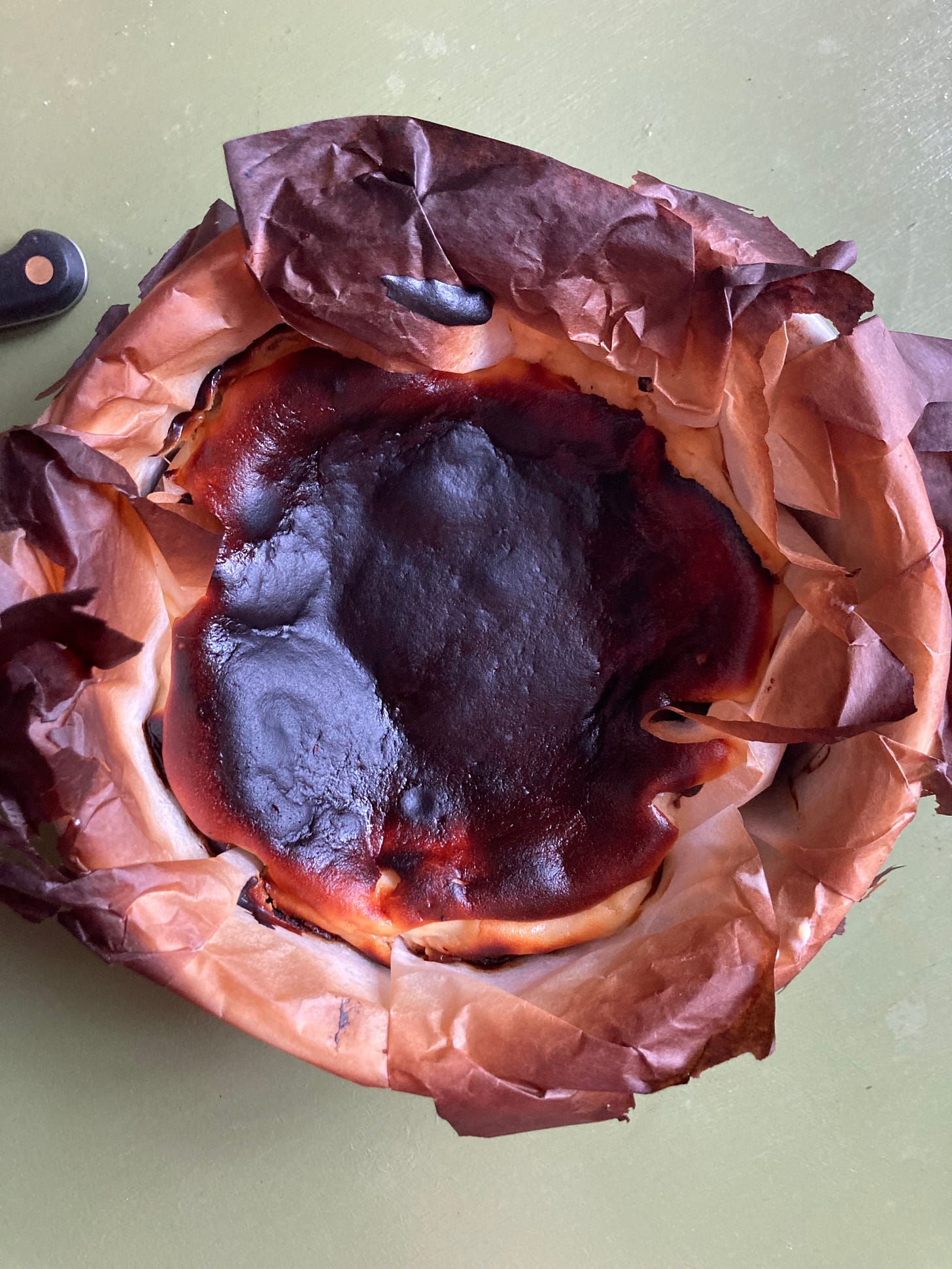

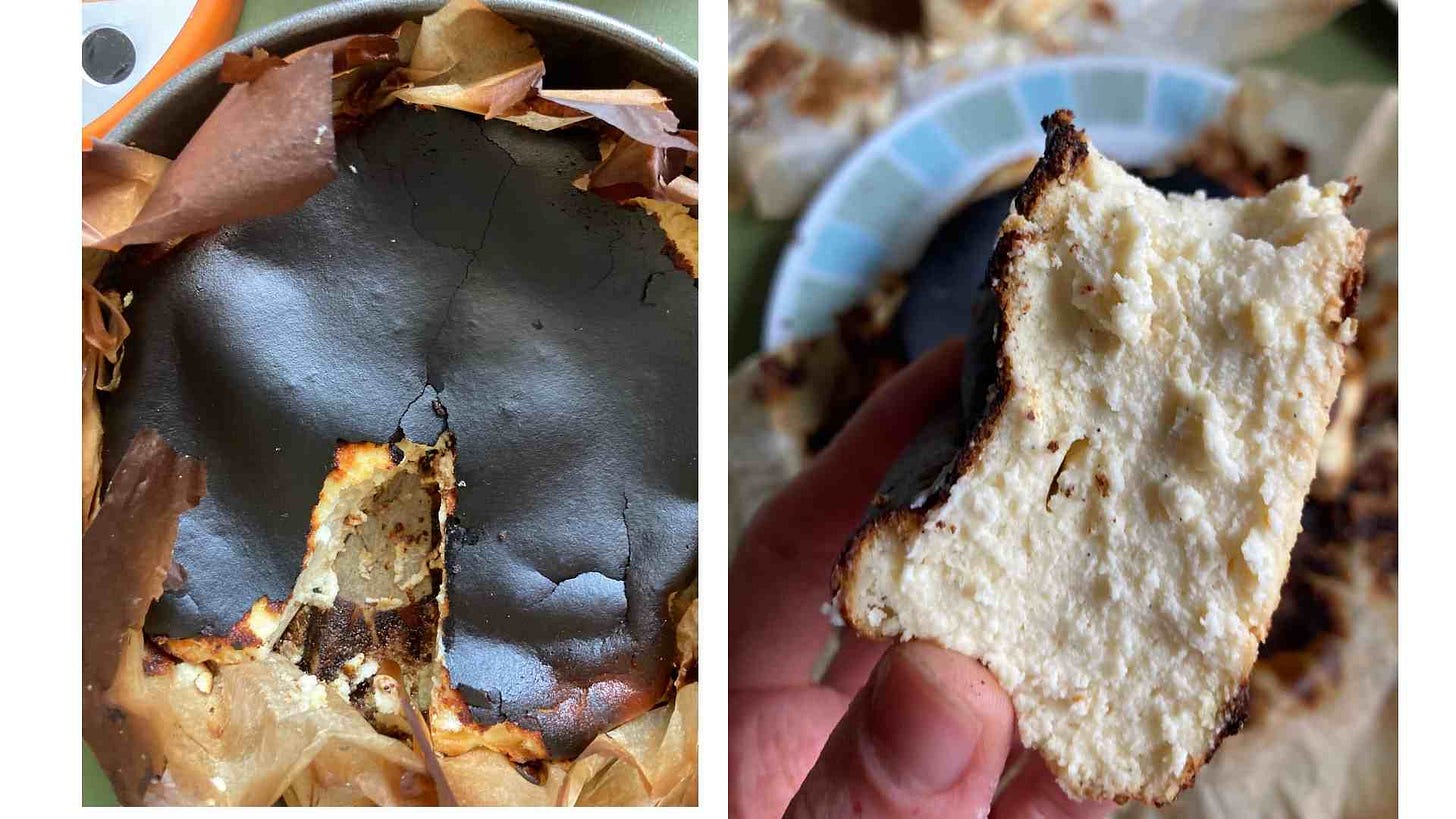
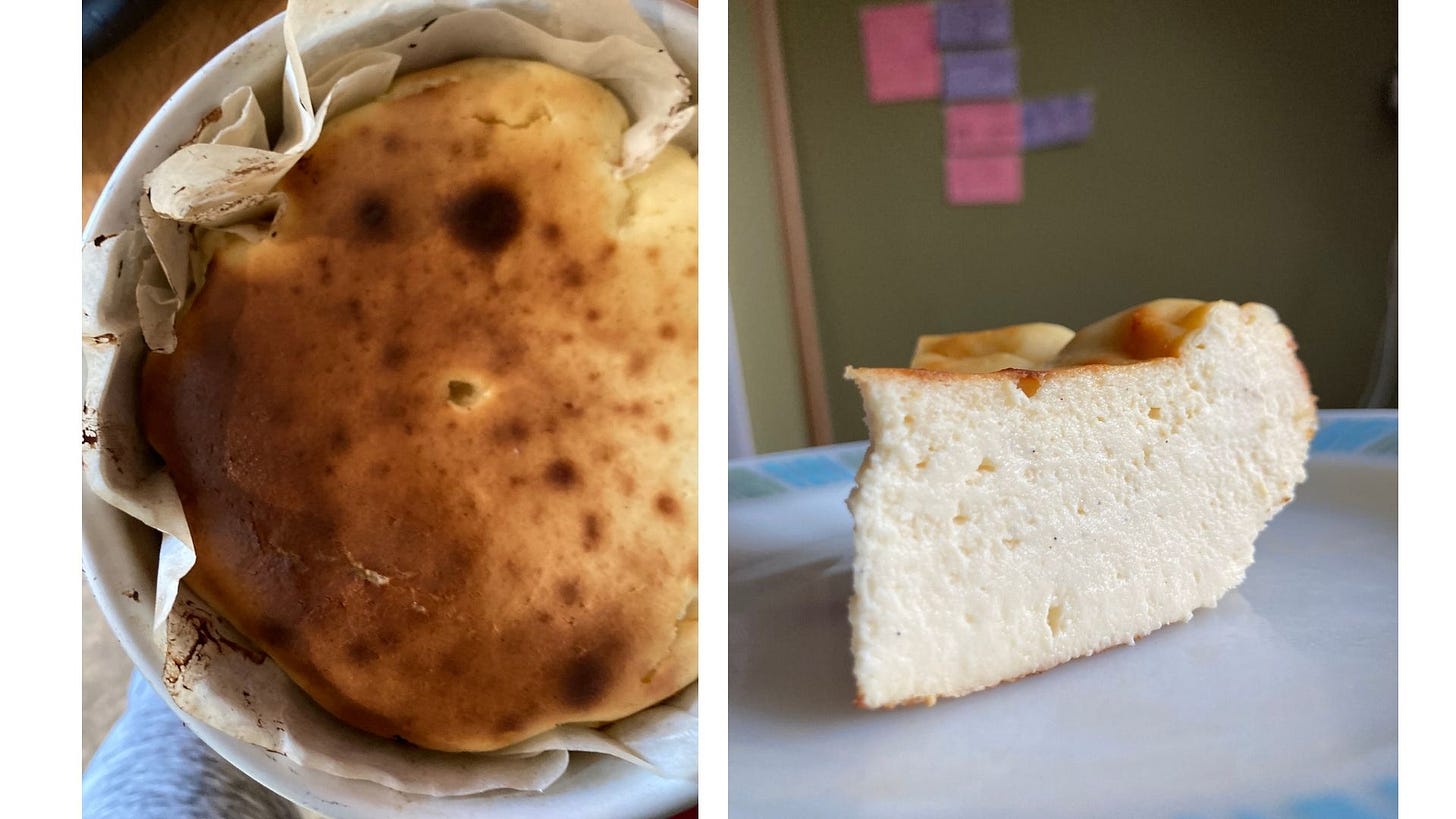
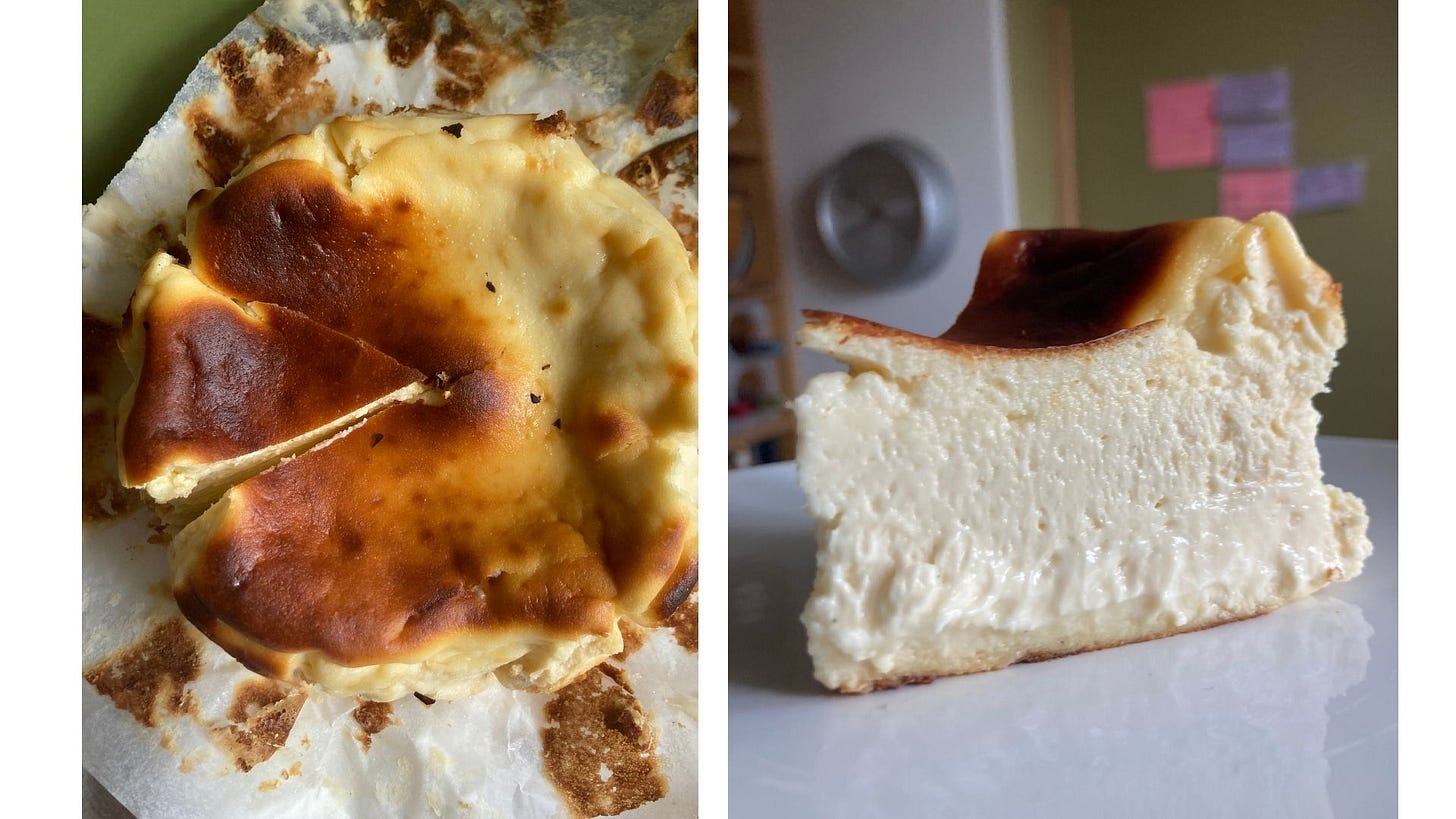
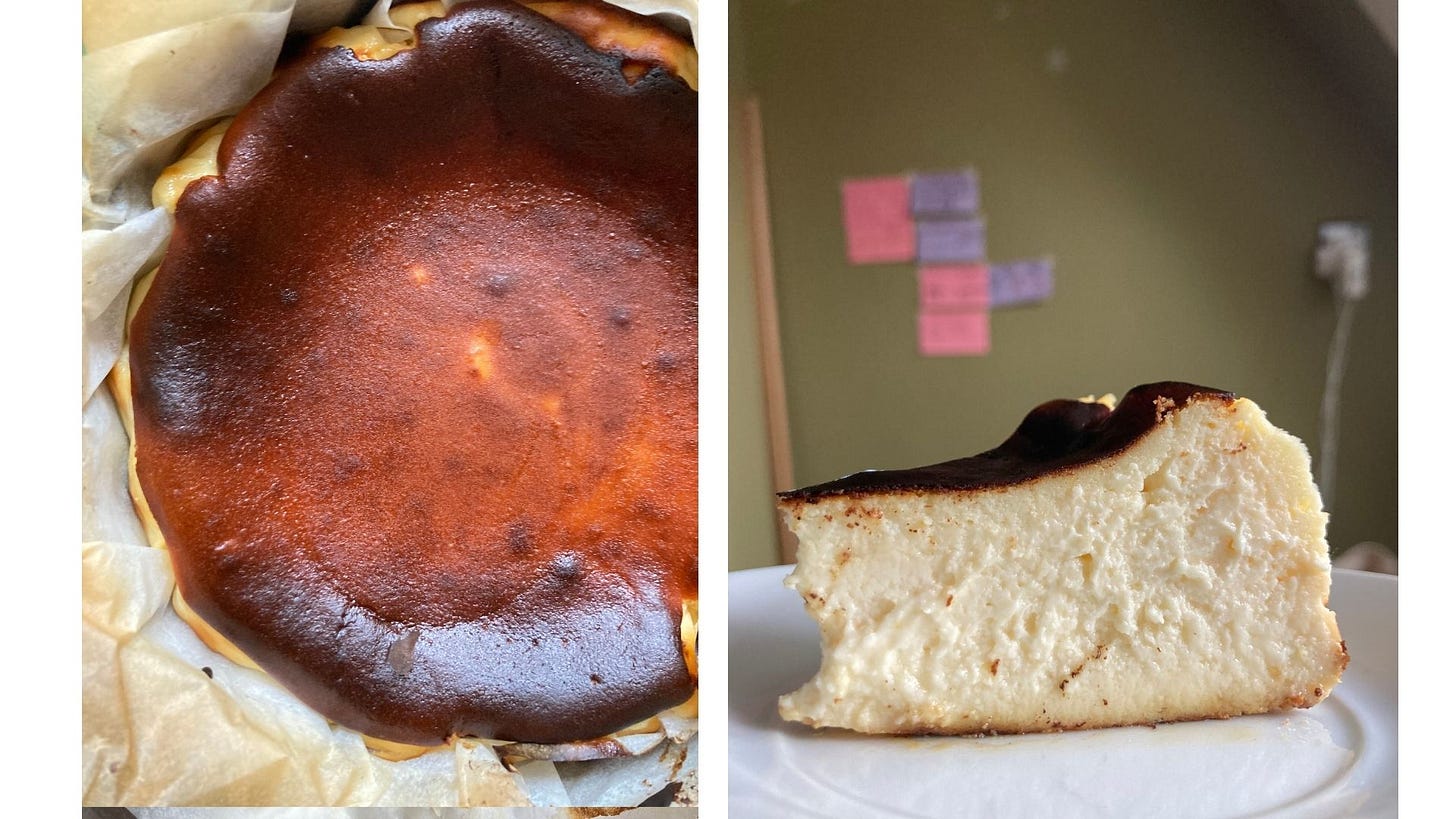
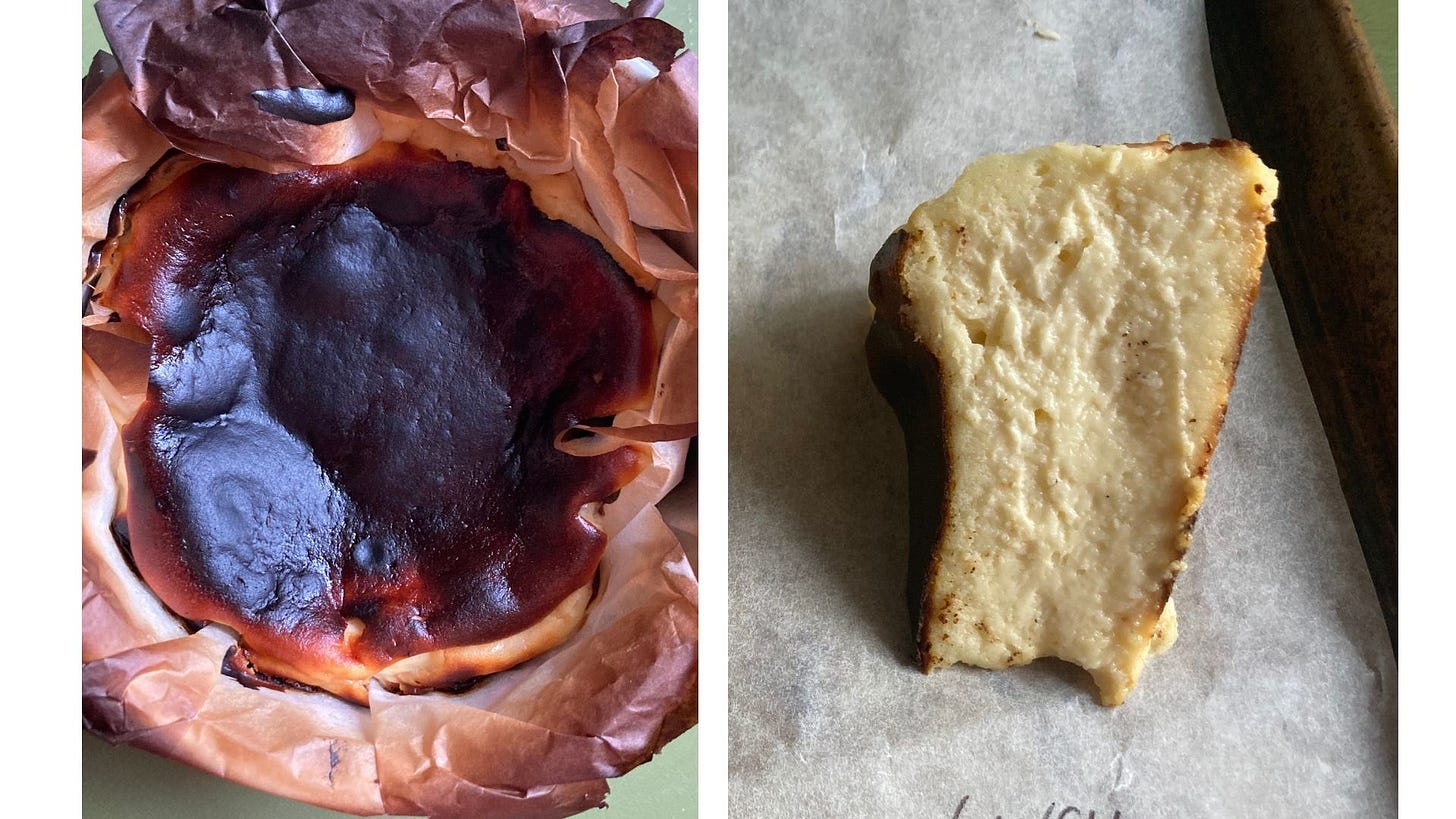

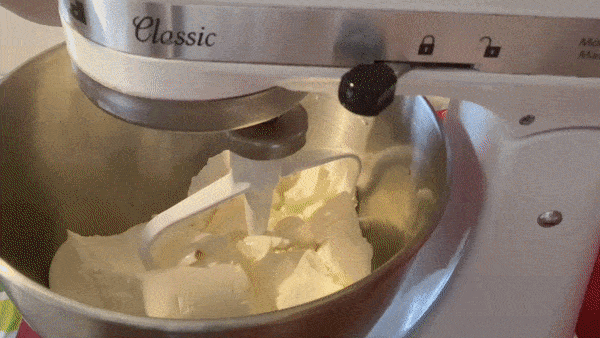
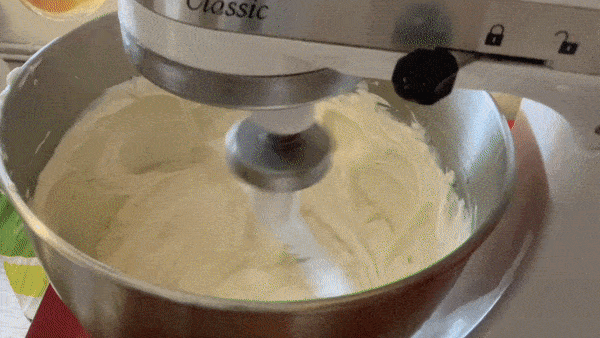
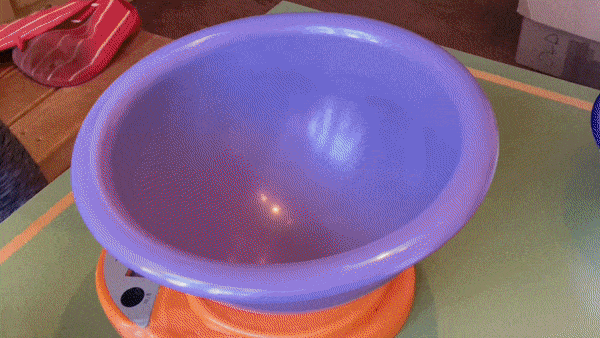
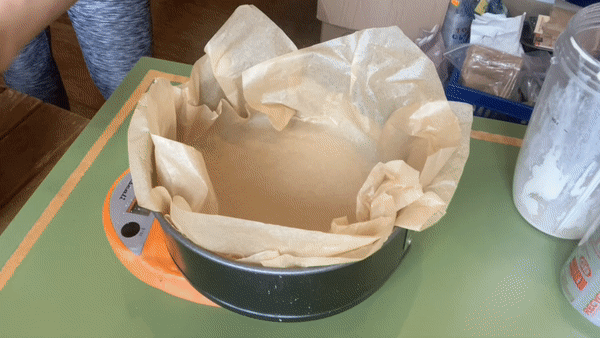
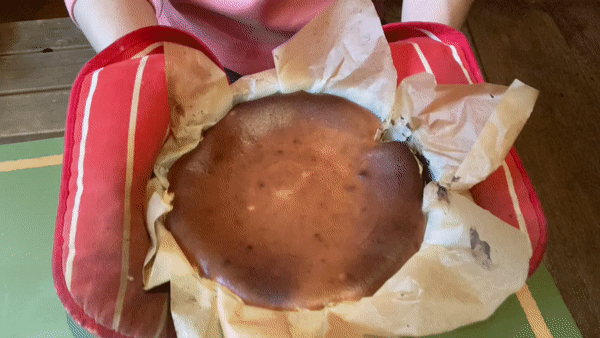
Thank you Nicola! I’m so sorry to be a pain but I’m really dying to make this recipe and still looks a bit funny to me! so just confirming I’m not misreading for 6”, cream cheese - 390, double cream-90, sour cream- 90, sugar -130, eggs - 130 (is this grams??), salt- 4, flour- 17??
Hi! I’m a little late the party here but looks like there’s a typo in the ingredients and the flour is missing? Anyone know the quantities?